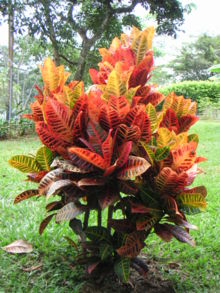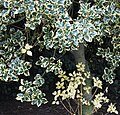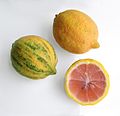Variegation

A variegation ( lat. Variegare , varied make ') or variegation ( double. Panacher , mix') is the occurrence of differently colored zones on plants . It is mainly caused by a local deficiency or lack of chlorophyll , which leads to greenish-white to yellowish spots. In addition, pigments ( xanthophylls and carotenes ) deposited evenly or zonally in the epidermis can create additional colors and color zones on the mottled background. Variegations on leaves are particularly noticeable, but they can appear on any green part of a plant. In succulent plants with missing or severely reduced leaves, variegations of the otherwise green shoots are very noticeable.
Definitions in the literature
- Variegate plants are plants that develop spots of different colors in the vegetation part.
- Variegation is a phenomenon of discrete patterns of different colors in organs or in the organism. Variegations in plants appear as lines, spots and stripes or as different colors between the leaf edge and the leaf center.
- Variegation is an irregular change in the color of plant organs, such as leaves and flowers, due to the suppression of normal pigment development.
Manifestations
In some plant species, variegations are normal and occur regularly. In these cases, the patterns are usually symmetrical and often have a comprehensible function, e.g. B. point on foliage like an arrow in the direction of the flowers and on bracts in the direction of the nectaries . Examples are the bright patterns on the leaves of the native meadow clover ( Trifolium pratense ) and the brightly striped leaves of the croton ( Codiaeum variegatum ).
In other species, variegations occur only rarely and in exceptional cases. If these rare forms are picked out, multiplied and, if necessary, cultivated, they are later available in stores. As an addition to their botanical names , they are often given a 'Variegata' or 'Variegatum', sometimes a fantasy name. Plants with white or colored-edged leaves are relatively common. Sometimes even whole leaves or shoot sections lack chlorophyll. If these parts are further propagated by grafting , completely chlorophyll-free plants emerge, which, however, are no longer viable on their own, since they cannot photosynthesize without chlorophyll. The plant can only survive if it is grafted onto a normally green segment. Even from white seedlings that sometimes appear in sowing, completely chlorophyll-free plants can be grown by grafting.
Leaves of the meadow clover ( Trifolium pratense )
Green nettle leaves ( Solenostemon scutellarioides )
Harlequin willow leaves ( Salix integra )
Leaves of a holly ( Ilex aquifolium )
Spread lemons ("Eureka Rosa")
causes
There are several possible reasons for a variegation.
- The regular patterns found in many species are genetically fixed. They are created by switching a gene involved in chlorophyll formation on and off at intervals during growth.
- Irregularly distributed spots are typical of chimeras , sometimes also called mosaics, in which two different cell lines occur next to each other.
- Normal green but clearly different shading spots are typical of ploidy chimeras. The cause is a mutation in which a cell with altered ploidy develops within a plant . The time at which the mutation occurs determines the extent to which chimeras are formed. If the mutation occurs very early, shortly after fertilization , the plant can contain both cell lines in approximately the same frequency and thus appear completely piebald. If the mutation occurs late in an already adult plant, it remains inconspicuous.
- Irregular light spots on the leaves of dicotyledonous plants and light stripes on the leaves of monocotyledonous plants are typical of segregation chimeras. The cause is a mutation in which part of the chloroplasts within a plant cell is damaged. Since the chloroplasts are randomly distributed to the daughter cells during a subsequent cell division , there is a certain probability that segregation occurs. Cells that happen to have received no functional chloroplasts grow into visibly bright areas in the course of further cell divisions. Here, too, the point in time of the mutation determines the appearance of the plant.
- Chimeric tissue can also spontaneously form at the interface of a graft and a piebald plant can emerge from it. An in vitro breeding, are generated by the deliberately composed of different cell lines plants, this is a technical variant.
- Variegations can also be symptoms of the disease.
- Typically large-scale discoloration of previously green plants are signs of chlorosis , a deficiency in plants.
- Small-area, typically mosaic-like stains are caused by virus infections , such as the tobacco mosaic virus , which can affect many other plants in addition to tobacco .
- The complete absence of chlorophyll in white seedlings is based on a serious genetic defect caused by mutation .
Scion of a Euphorbia ammak
Scion of a Euphorbia mammillaris
Scion of a chlorophyll-free Gymnocalycium
Scion of a chlorophyll-free Gymnocalycium
Effects
In the absence of color-giving chloroplasts in plant cells, photosynthesis is not possible in these . This means that the affected cells cannot live autotrophically , but have to be nourished by the photosynthesis products of the green parts of the plant. This applies to all cells in the plant organism that do not contain chlorophyll , including root cells and cells further inside the shoot . A high proportion of variegated leaf areas can lead to a loss of vitality in the plant .
literature
- Erich Lüthje: white + green = variegated? Comparative study of white-green leaves , Biologie in our time 28 (3): 181-185, 2005
Individual evidence
- ^ Richard AE Tilney-Bassett: Genetics of Variegation and Maternal Inheritance in Ornamentals . In J. Harding, F. Singh and JNM Mol (eds.): Genetics and Breeding of Ornamental Species , Kluwer Academic Publishers, Dordrecht, 1991
- ↑ Michael Marcotrigiano: Chimeras and Variegation: Patterns of Deceit. HortScience (1997) 32 (5): 773-784, 1997
- ^ Rudolf Schubert & Günther Wagner: Botanical Dictionary, Eugen Ulmer Verlag, Stuttgart, 1991








